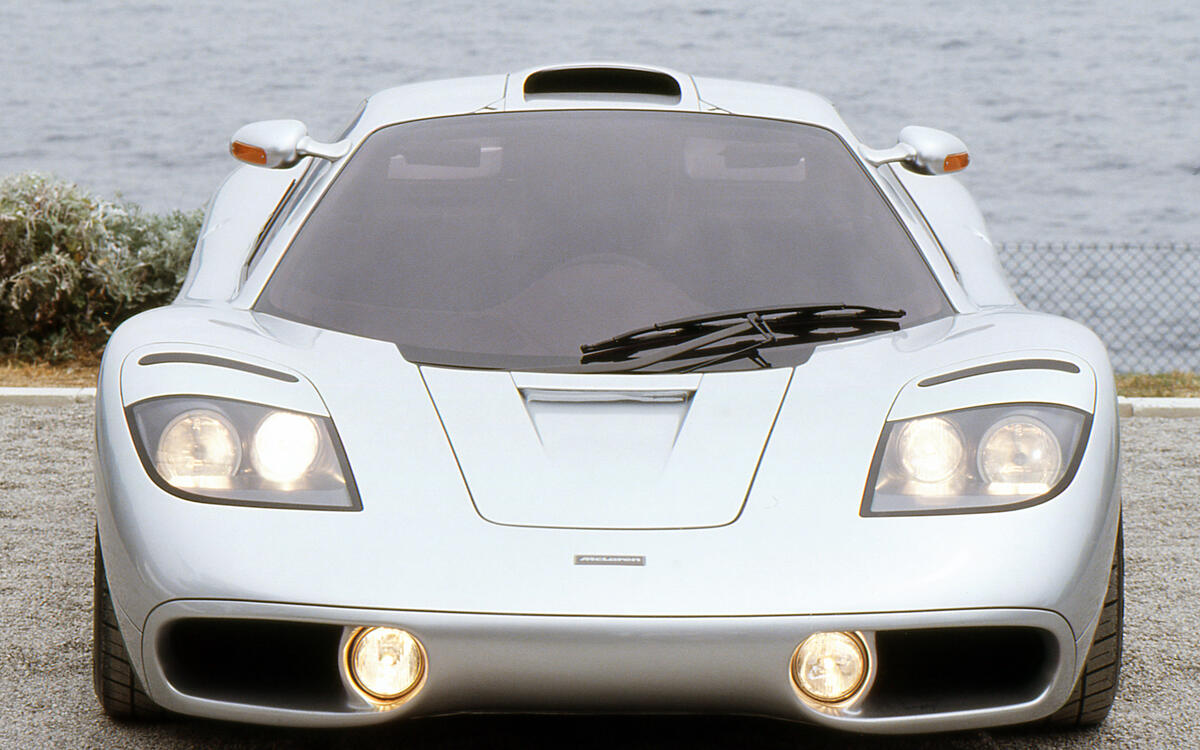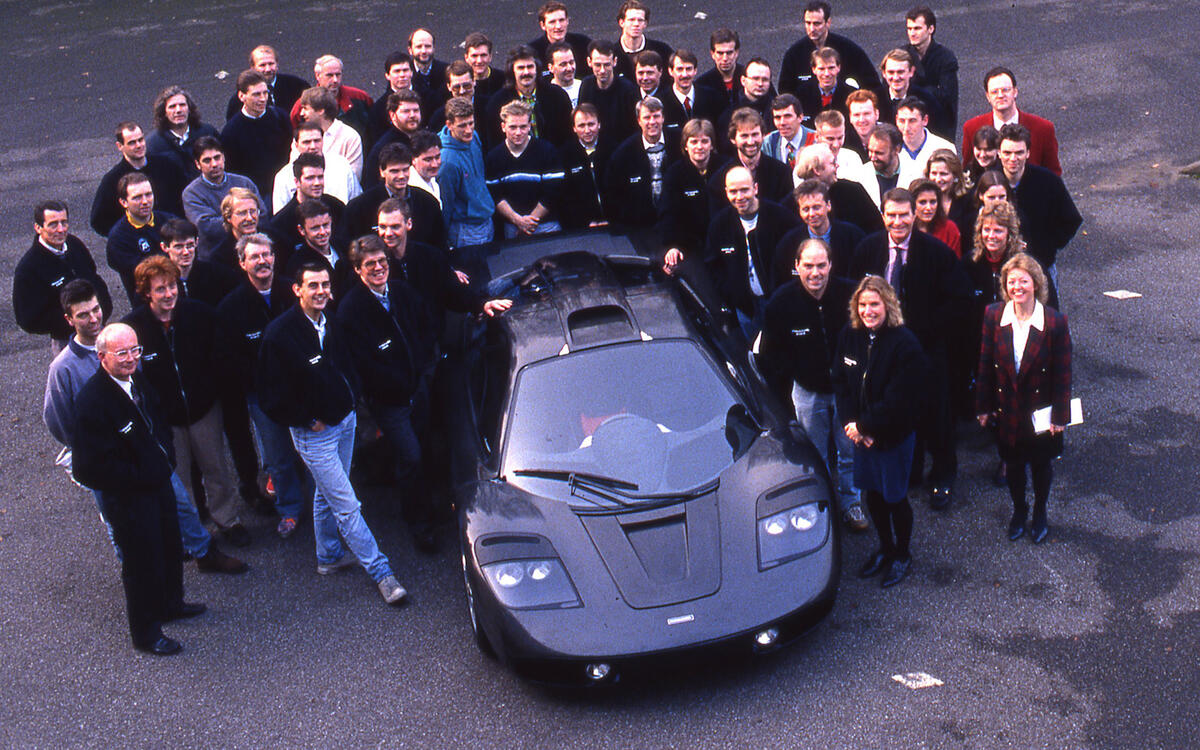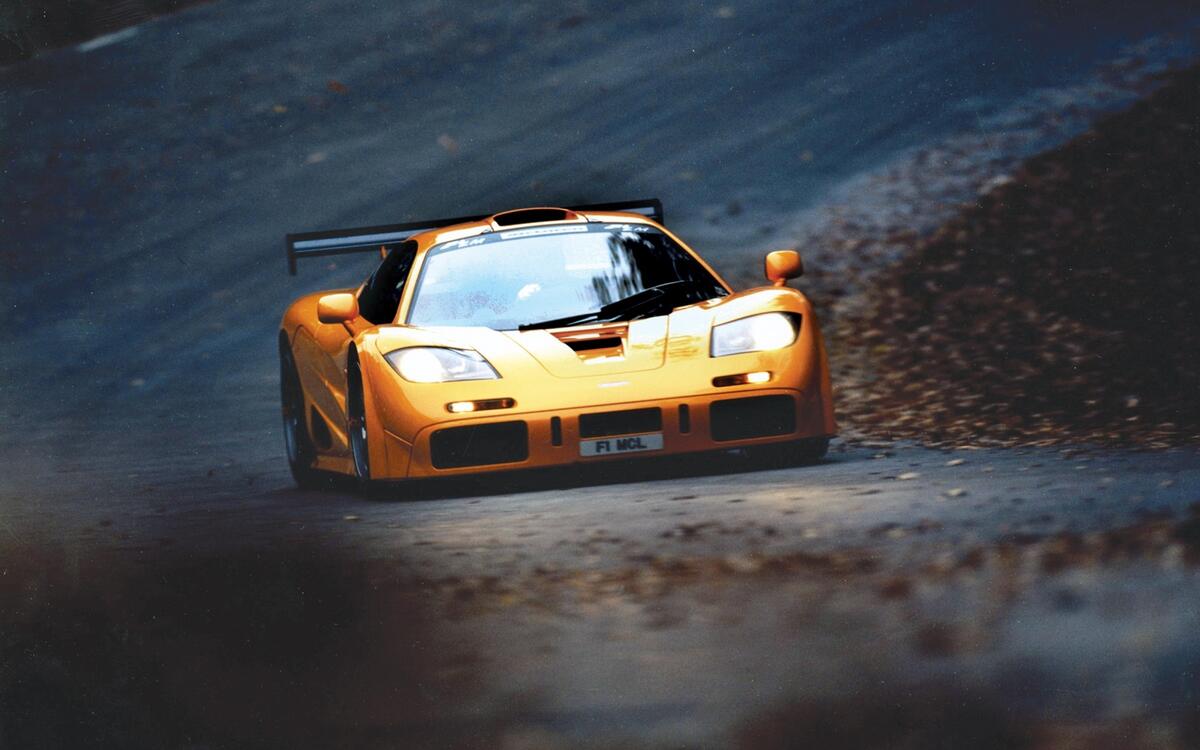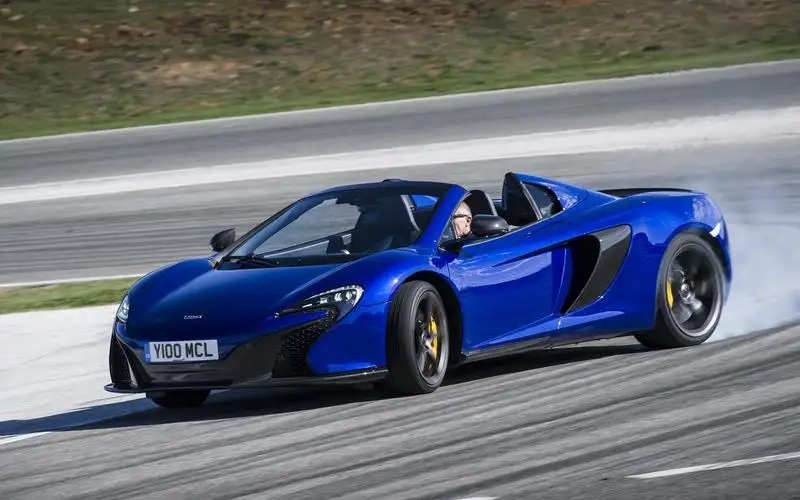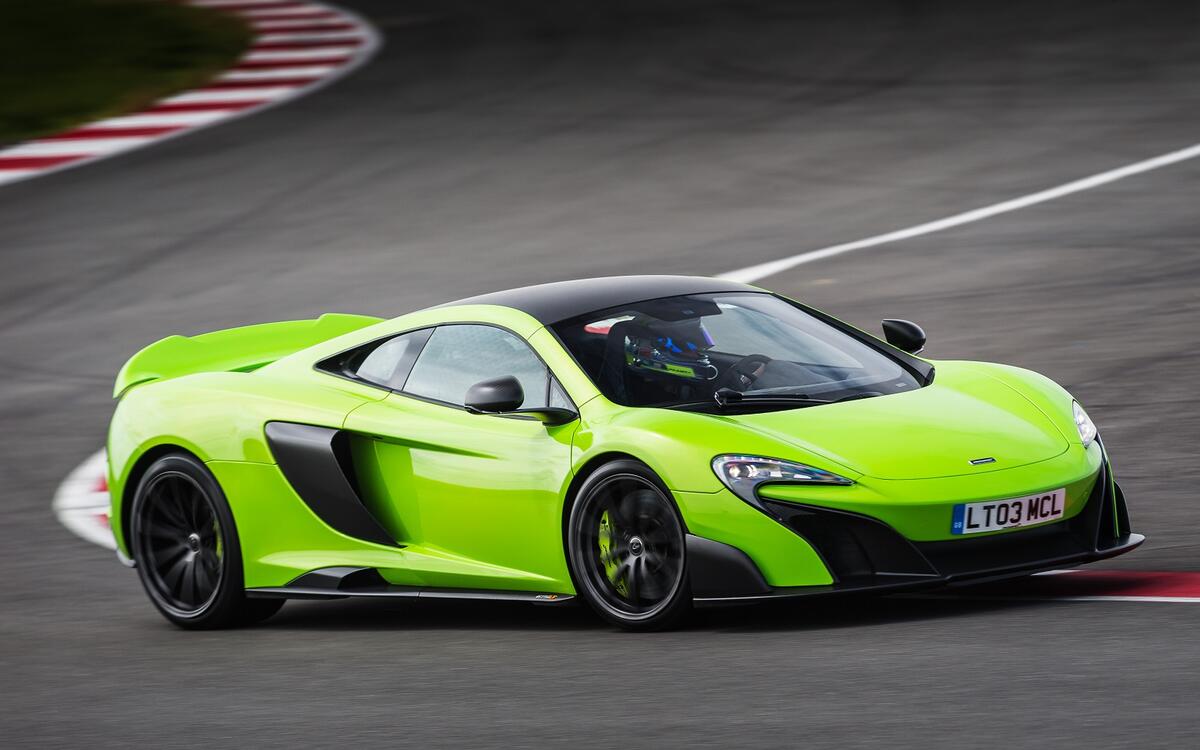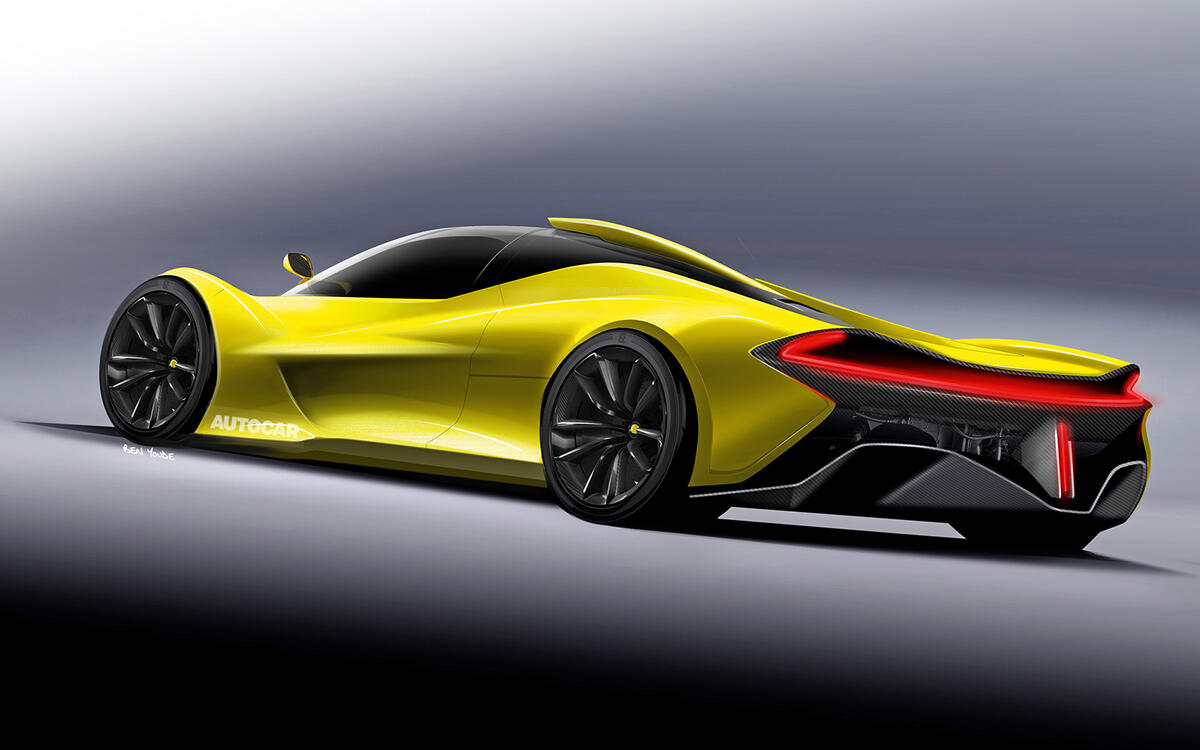 Slide of
Slide of
McLaren could have remained a successful maker of race cars that’s essentially unknown outside of the pits, like Lola and Chaparral.
Instead, the firm recently evolved into one of Ferrari’s worst nightmares. Here’s how it rose above its peers and transferred the lessons it learned on the track to a growing line-up of world-beating supercars.
 Slide of
Slide of
The beginning (1950)
Company founder Bruce McLaren discovered a love for cars early on. In 1950, the 13-year old New Zealander talked his father (both pictured) into converting a 1929 Austin Ulster into a race car. The two years spent working on the project taught McLaren the basics of building a performance car. At only 15, he set the fastest time in the 750cc category at the Muriwai Beach Hill Climb in the family Ulster.
McLaren travelled to Europe in 1958 to begin his racing career. He founded Bruce McLaren Motor Racing in 1963 and the team quickly morphed into a full-blown Formula 1 effort. By the 1980s, McLaren had become a household name in the tight-knit racing community, one with numerous victories under its belt and a reputation for innovation.
 Slide of
Slide of
McLaren’s first road car (1970)
McLaren naturally thought of making a road car to beat rivals like Ferrari on the street. In 1970, the company teamed up with Trojan to build a model called M6GT. It was based on the M6A, a race car designed for the Can-Am series, but it used a Chevrolet-sourced, 5.7-litre V8 with 370hp. Already, McLaren experimented with lightweight materials like resin and aluminium.
The team wanted to race the M6GT in the Group 4 category but it couldn’t build the 50 cars required for homologation in time. The company might have found a solution had Bruce McLaren not died in an accident in 1970. Just three examples of the M6GT saw the light of day, including one the company’s founder used on a regular basis before his death.
 Slide of
Slide of
All thanks to a late flight (1988)
In 1993, McLaren seemingly came out of the Formula 1 pits with a world-beating supercar named F1. Few people outside of the company saw it coming.
Tracing the model’s origins requires traveling back to 1988. Company chairman Ron Dennis, wealthy shareholder Mansour Ojjeh, technical director Gordon Murray and head of marketing Creighton Brown waited for a delayed flight out of Milan airport. As the hours passed, they brainstormed different ways to capitalize on McLaren’s success on the track. The conversation quickly turned to building another road car.
 Slide of
Slide of
McLaren’s tall order (1989)
The M6GT notwithstanding, McLaren had no experience building road cars and certainly not even a shadow of a dealer network through which to distribute them. That didn’t stop the four men from founding McLaren Cars and starting work on the project.
They held a design meeting to set the basic guidelines. The car needed to be the fastest and best-handling car on the planet, it had to offer the best power-to-weight ratio of any production car on sale at the time, yet it needed to be comfortable and usable daily. Talk about a tall order.
 Slide of
Slide of
The project begins (1989)
Unfazed, McLaren started working on the car. From the start, the team decided to use carbon fibre to keep weight in check. It was a common material in Formula 1, but McLaren became the first auto-maker to build a carbon fibre monocoque for a street-legal, regular-production car. Designer Peter Stevens drew the F1 entirely by hand.
 Slide of
Slide of
The F1 (1992)
McLaren showed the F1 to the public for the first time during the 1992 Monaco Grand Prix, a coup it promptly trumped by then winning the race. Jaws dropped and wallets opened. McLaren received more orders than it expected in spite of the F1’s lofty £634,500 (around US$1.14 million at the time) base price. It was as impressive on paper as it was on the streets of Monaco.
McLaren opted not to develop an engine from scratch, and it couldn’t persuade its Formula One partner Honda to design a 10- or 12-cylinder engine, so it turned towards Germany. The F1 used a BMW-designed 6.1-litre V12 that provide 627hp and 480lb-ft. of torque. The firm famously lined parts of the engine bay with heat-reflecting gold foil. Inside, it offered space for three occupants in an unusual configuration. Putting the driver in the centre, it notably and neatly eliminated the need to make left- and right-hand drive cars.
 Slide of
Slide of
The F1 LM (1995)
McLaren never intended to race the F1; it was a street car above all. The company remembers its customers ultimately convinced Ron Dennis to hit the track.
The F1 GTR won the 1995 24 Hours of Le Mans, an immense achievement for a company that had never competed in the event before. McLaren celebrated the occasion by launching a lighter, more hardcore evolution of the F1 appropriately named LM. It received many of the features that helped the F1 clinch its first Le Mans victory including a unique body kit, wider wheels, a stripped-out interior and straight-cut gears in the transmission. The company called it ‘an untamed Le Mans race car with number plates’.
 Slide of
Slide of
The end of the F1 (1998)
McLaren ended F1 production in 1998 after building a total of 106 cars including prototypes and race versions. The world kept an eye out for a successor that took its time arriving. Would enthusiasts have to wait another quarter of a century for McLaren’s next road car? Not quite. Only about half that.
This picture shows Murray (centre) with Jonathan Palmer (left) and F1 champion Mika Häkkinen.
 Slide of
Slide of
The German McLaren (2004)
Mercedes-Benz and Formula 1 partner McLaren teamed up to make the Vision SLR concept from the 1999 Detroit motor show a reality. Fast, complex and expensive, the SLR McLaren was built by hand in the British firm’s Woking facility, becoming the first and so far only British-built road car to wear the three-pointed-star. McLaren’s contributions to the project included moving the engine back to improve the weight distribution.
The SLR however never sold as well as Mercedes hoped. 2157 examples were sold over seven years, against an original target of 3500.
 Slide of
Slide of
The P11 (2009)
In 2009, Autocar published pictures of a fully camouflaged test mule called P11 testing at the Nürburgring. At the time, we reported seeing a model similar in size to the Ferrari F430 and speculated it might use a V8 engine sourced from the Mercedes-Benz parts bin. Later, rumours claimed the relationship between the two partners soured and Mercedes consequently refused to provide McLaren with its AMG-built 6.3-litre V8.
 Slide of
Slide of
The MP4-12C (2010)
McLaren finally took the camouflage off in late 2009. Called MP4-12C, a name borrowed from the company’s 1997 Formula 1 entry, the coupe represented McLaren’s dedication to taking down Ferrari once and for all. It wasn’t a direct successor to the F1. In shape, performance, and price the MP4-12C clearly had the F430 in its crosshairs.
Engineers built the car – which later spawned a convertible – on a carbon fibre tub and powered it by a twin-turbocharged 3.8-litre V8 engine mounted behind the passenger compartment. Every McLaren road car produced to date has followed this same basic recipe.
 Slide of
Slide of
The X-1 (2012)
While it’s difficult to tell by looking at the exterior, the Batmobile-esque X-1 started life as an MP4-12C. It’s a one-off model built at the request of a wealthy collector who asked to remain anonymous. Oddly, McLaren explained inspiration for the model came from a variety of sources including a 1961 Facel Vega, a 1971 Citroen SM, various examples of architecture, an Airstream trailer, a Thomas Mann Montblanc pen and an eggplant – seriously.
 Slide of
Slide of
The P1 (2013)
When it launched the MP4-12C, McLaren promised to speed up the cadence of its new model introductions. It made good on its promise by bringing the hotly-anticipated P1 to the 2013 Geneva motor show. The big surprise came when the sheet came off: McLaren had built a hybrid.
It wasn’t a conventional hybrid powertrain, however. McLaren fused an evolution of the MP4-12C’s 3.8-liter twin-turbocharged petrol engine, an electric motor, and a high-density battery pack to summon 903bhp. The P1 could drive on electricity alone for short distances.
 Slide of
Slide of
The 650S (2014)
The MP4-12C evolved into the 650S in early 2014. McLaren explained about 25 percent of the parts that made up the model were new while the rest were shared with the older car. The changes included visual tweaks to bring both the coupe and Spider body styles in line with the P1’s design language, a more powerful V8 engine and chassis modifications for improved handling.
Shortly after launching the 650S, the company announced the end of the MP4-12C’s production run.
 Slide of
Slide of
From the track to the street to the track again (2014)
Track-bred technology influenced McLaren’s line-up of street-legal cars. The firm funnelled what it learned from these machines back into racing by building track-only variants of the P1 and the 650S named GTR and GT3, respectively. The 650S GT3 arrived in 2014, while McLaren unveiled the bonkers P1 GTR at the 2015 Geneva motor show.
 Slide of
Slide of
The 675LT (2015)
Inspired by the F1 Longtail, McLaren introduced an evolution of the 650S named 675LT. Presented as a more track-focused model, it received a longer rear end that generated 40 percent more downforce than the 650S could offer. And with 666bhp on tap, the 675LT became the fastest member of the Super Series family when it broke cover.
 Slide of
Slide of
The 570S (2015)
The new model floodgates had opened. Just a few months after presenting the 675LT, McLaren travelled to the New York auto show to unveil yet another addition to its line-up. The 570S inaugurated the company’s Sports Series, a range of daily-drivable cars with a slightly less venomous bite. It retained its faster sibling’s 3.8-litre V8 but its output dropped to 562bhp.
An entry-level model named 540C arrived at the 2015 Shanghai motor show. McLaren only distributed the car in select markets; notably, the 540C never disembarked on American shores.
 Slide of
Slide of
The 570GT (2016)
From the start, McLaren set out to build cars motorists can drive on a daily basis. It introduced the 570GT, its most usable car yet, at the 2016 Geneva motor show. The GT stood out with a more fastback-like silhouette than the 570S it was based on and it received a glass hatch mounted on a carbon fibre frame. The longer roof line gave the car more cargo space behind the seats. Mechanically, it retained the 570S’ V8 engine.
 Slide of
Slide of
The 10,000th McLaren (2016)
Though undeniably a gamble, McLaren’s return to the automotive industry paid off. In December 2016, the firm announced the 10,000th road car had rolled out of its Woking facility in southern England. It reached the milestone in a little over five years. The milestone car – a 570S – went straight to the McLaren Heritage Collection.
 Slide of
Slide of
The 720S (2017)
More than just a new car with a new name, the 720S represented the first direct model replacement in McLaren’s history. The design brief was clear: it had to be better than its predecessor, the 650S, in every way. It weighed less and it offered more power thanks to a 4.0-litre V8. Another way of looking at the 720S is that it offers more power than a Dodge Challenger Hellcat yet it weighs less than a Volkswagen Golf. It’s also considerably more tech-focused than its predecessor.
 Slide of
Slide of
The Senna (2018)
McLaren’s latest model made its public debut at this year’s Geneva motor show. Named Senna after the late Brazilian F1 driver, who won all three of his world championship titles with McLaren, it’s the second member of the company’s Ultimate Series.
McLaren calls it an ‘ultimate road-legal track car’ and points out it’s the most extreme car since its modern era started in 2010. Carbon fibre construction and a 789bhp V8 results in a 0-62mph time of 2.8sec and a top speed of 211mph.
 Slide of
Slide of
What’s next?
McLaren isn’t out of ideas. The firm is hard at work on a project called BP23 internally that will pick up where the F1 left off. It will boast a three-seater configuration and a petrol-electric hybrid powertrain built around a twin-turbocharged V8 engine, and this is our impression of how it may look. Look for the model to break cover before the end of the year. We hope you have already placed an order; it’s limited to 106 examples - in homage to the F1's production run - and it’s already sold out.
Looking ahead, McLaren will fully adopt hybrid powertrains. It told Autocar its next-generation sports cars will need to be fully electrified to comply with emissions norms around the word. An entirely electric model is possible, too, but not before 2022.
This journey starts with a 1929 Austin, and ends with the Senna.
Advertisement






